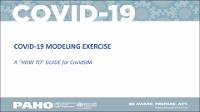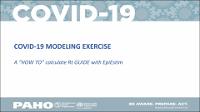COVID-19 Modeling Exercise Technical Guide: Methodology and Parameters, 4 May 2020
| dc.date.accessioned | 2020 | |
| dc.date.available | 2020 | |
| dc.date.issued | 2020 | |
| dc.identifier.govdoc | PAHO/IMS/PHE/COVID-19/20-0031 | |
| dc.identifier.uri | https://iris.paho.org/handle/10665.2/52405 | |
| dc.description.abstract | This modeling exercise aims to: 1. Understand the behavior of the epicurve for COVID-19 cases in countries. 2. Identify whether the current public health and social measures (PHSM) implemented in the country are helping to lower the effective reproductive number (Rt). 3. Identify the effect on the epicurve and the Rt of lifting the PHSM at any given date. | en_US |
| dc.language.iso | en | en_US |
| dc.publisher | PAHO | en_US |
| dc.rights | Attribution-NonCommercial-ShareAlike 3.0 IGO | * |
| dc.rights.uri | http://creativecommons.org/licenses/by-nc-sa/3.0/igo/ | * |
| dc.subject | COVID-19 | en_US |
| dc.subject | Coronavirus | en_US |
| dc.subject | Pandemics | en_US |
| dc.title | COVID-19 Modeling Exercise Technical Guide: Methodology and Parameters, 4 May 2020 | en_US |
| dc.type | Technical reports | en_US |
| dc.rights.holder | Pan American Health Organization | en_US |
| dc.contributor.corporatename | Pan American Health Organization | en_US |
| paho.isfeatured | 0 | en_US |
| paho.publisher.country | United States | en_US |
| paho.publisher.city | Washington, D.C. | en_US |
| paho.source.centercode | US1.1 | en_US |
| paho.relation.languageVersion | 10665.2/52368 | |
| paho.contributor.department | Health Emergencies (PHE) | en_US |
| paho.iswhotranslation | No | en_US |







